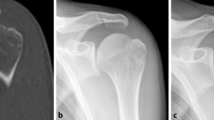Abstract
Purpose
The purpose of this retrospective study was to evaluate the early results of arthroscopic treatment in patients with missed occult greater tuberosity (GT) fracture of the humerus using the arthroscopic suture–bridge fixation technique.
Methods
Between January 2007 and August 2010, we used arthroscopic suture–bridge fixation in 15 cases of missed occult GT fractures, which were referred to our department with persistent symptoms following trauma, despite physical therapy. Occult GT fracture was diagnosed with bone marrow edema seen on magnetic resonance imaging in all patients. There were 13 male and 2 female patients with a mean age of 45 years (range 31–67 years). Mean time period until the surgery following the initial trauma was 4 months (1.5–12 months). For the measurement of clinical outcomes, we assessed the range of motion and evaluated the University of California, Los Angeles (UCLA) American Shoulder and Elbow Surgeons (ASES) scores and simple shoulder test (SST).
Results
The early clinical results were evaluated in these patients at a mean of 24 months (range 14–36 months) after surgery. All the patients were satisfied with the surgery. The mean UCLA, ASES, and SST scores improved from preoperative 15, 39, and 2 to postoperative 33, 91, and 11, respectively (P < .05). Mean forward flexion, abduction, external rotation at the neutral position, and internal rotation were improved to 159°, 155°, 24°, and L1, respectively, at the final follow-up.
Conclusion
In the occult GT fracture with persistent shoulder symptoms, arthroscopic suture–bridge fixation and early rehabilitation showed excellent clinical outcomes on a short-term follow-up study.
Level of evidence
Retrospective review, Level IV.


Similar content being viewed by others
References
Gumina S, Carbone S, Postacchini F (2009) Occult fractures of the greater tuberosity of the humerus. Int Orthop 33:171–174
Mason BJ, Kier R, Bindleglass DF (1999) Occult fractures of the greater tuberosity of the humerus: radiographic and MR imaging findings. AJR Am J Roetgenol 172:469–473
Ogawa K, Yoshida A, Ikegami H (2003) Isolated fractures of the greater tuberosity of the humerus: solutions to recognizing a frequently overlooked fracture. J Trauma 54:713–717
Beredjiklian PK, Iannotti JP, Norris TR, Williams GR (1998) Operative treatment of malunion of a fracture of the proximal aspect of the humerus. J Bone Joint Surg Am 80:1484–1497
Craig EV (2004) Operative treatment of tuberosity fractures, malunions and nonunions. In: Craig EV (ed) The shoulder. Lippincott Williams & Wilkins, Philadelphia, pp 495–511
Siegel JA, Dinex DM (2000) Proximal humerus malunions. Orthop Clin N Am 31:35–50
Beredjiklian PK, Iannotti JP (1998) Treatment of proximal humerus fracture malunion with prosthetic arthroplasty. Instr Course Lect 47:135–140
Ji JH, Kim WY, Ra KH (2007) Arthroscopic double-row suture anchor fixation of minimally displaced greater tuberosity fractures. Arthroscopy 23:1133–1134
Ji JH, Shafi M, Song IS, Kim YY, McFarland EG, Moon CY (2010) Arthroscopic fixation technique for comminuted, displaced greater tuberosity fracture. Arthroscopy 26:600–609
Kim KC, Rhee KJ, Shin HD, Kim YM (2008) Arthroscopic fixation for displaced greater tuberosity fracture using the suture–bridge technique. Arthroscopy 24(120):e1–e3
Berger PE, Ofstein RA, Jackson DW, Morrison DS, Silvino N, Amador R (1989) MRI demonstration of radiographically occult fractures: what have we been missing? Radiographics 9:407–436
Ahn JM, El-Khoury GY (2007) Occult fractures of extremities. Radiol Clin N Am 45:561–579
Patten RM, Mack LA, Wang KY, Lingel J (1992) Nondisplaced fractures of the greater tuberosity of the humerus: sonographic detection. Radiology 182:201–204
Kessel L, Bayley Ian (eds) (1997) Clinical disorders of the shoulder. Churchill Livingstone, Edinburgh
Kim E, Shin HK, Kim CH (2005) Characteristics of an isolated greater tuberosity fracture of the humerus. J Orthop Sci 10:441–444
Neer CS II (1970) Displaced proximal humeral fractures. I. Classification and evaluation. J Bone Joint Surg Am 52:1077–1089
Bigliani LU, Pollock RG (1998) The shoulder. W.B. Saunders, Philadelphia
Green A, Izzi J Jr (2003) Isolated fractures of the greater tuberosity of the proximal humerus. J Should Elbow Surg 12:641–649
Taverna E, Sansone V, Battistella F (2004) Arthroscopic treatment for greater tuberosity fractures: rationale and surgical technique. Arthroscopy 20:e53–e57
Gartsman GM, Taverna E (1996) Arthroscopic treatment of rotator cuff tear and greater tuberosity fracture nonunion. Arthroscopy 12:242–244
Porcellini G, Campi F, Paladini P (2002) Articular impingement in malunited fracture of the humeral head. Arthroscopy 18:E39
Ji JH, Moon CY, Kim YY, Shafi M (2009) Arthroscopic fixation for a malunited greater tuberosity fracture using the suture–bridge technique: technical report and literature review. Knee Surg Sports Traumatol Arthrosc 17:1473–1476
Martinez AA, Calvo A, Domingo J, Cuenca J, Herrera A (2010) Arthroscopic treatment for malunions of the proximal humeral greater tuberosity. Int Orthop 34:1207–1211
Brady PC, Arrigoni P, Burkhart SS (2006) Evaluation of residual rotator cuff defects after in vivo single- versus double-row rotator cuff repairs. Arthroscopy 22:1070–1077
Lo IK, Burkhart SS (2003) Double-row arthroscopic rotator cuff repair: re-establishing the footprint of the rotator cuff. Arthroscopy 19:1035–1042
Frank JB, ElAttrache NS, Dines JS, Blackburn A, Crues J, Tibone JE (2008) Repair site integrity after arthroscopic transosseous–equivalent suture–bridge rotator cuff repair. Am J Sports Med 36:1496–1503
Park MC, Elattrache NS, Ahmad CS, Tibone JE (2006) “Transosseous–equivalent” rotator cuff repair technique. Arthroscopy 22:1360e1–1360e5
Conflict of interest
No funds were received in support of this study.
Author information
Authors and Affiliations
Corresponding author
Rights and permissions
About this article
Cite this article
Park, SE., Ji, JH., Shafi, M. et al. Arthroscopic management of occult greater tuberosity fracture of the shoulder. Eur J Orthop Surg Traumatol 24, 475–482 (2014). https://doi.org/10.1007/s00590-013-1212-3
Received:
Accepted:
Published:
Issue Date:
DOI: https://doi.org/10.1007/s00590-013-1212-3




